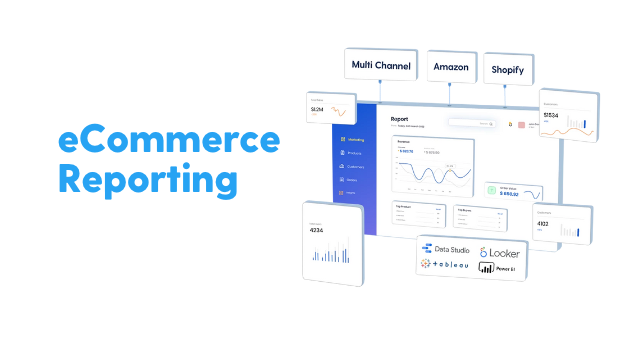eCommerce reporting is the process of collecting, analyzing, and presenting data about an online store’s performance. This can include data on sales, customer behavior, marketing campaigns, and other key metrics.
eCommerce reporting can help businesses understand the health of their online store and identify areas for improvement. It can also help businesses make informed decisions about their eCommerce strategy, such as which products to promote, how to optimize the website for conversions, and how to best allocate marketing resources.
eCommerce Reporting Challenges
There are several challenges that businesses may face when it comes to eCommerce reporting. Some of these challenges include:
- Data accuracy: Ensuring that the data being collected and analyzed is accurate is crucial for making informed decisions. However, data can be prone to errors or inconsistencies, which can impact the accuracy of eCommerce reports.
- Data integration: One challenge is integrating data from multiple sources, such as online sales platforms, point-of-sale systems, marketing platforms, and customer relationship management systems. This can require significant time and resources to clean, transform, and standardize the data to ensure it is compatible and can be effectively blended.
Read more – eCommerce data connectors - Data security: Protecting sensitive data, such as customer information, is a top priority for businesses. Ensuring that data is secure and protected from unauthorized access can be a challenge when it comes to eCommerce reporting.
- Data overload: With so much data available, it can be overwhelming to sort through and analyze all of it. This can make it challenging for businesses to identify the most important metrics and focus on the data that is most relevant to their needs.
- Limited resources: Small businesses may have limited resources, such as time and staff, to devote to eCommerce reporting. This can make it challenging for these businesses to keep up with the data and make the most of it.
- Data governance: Establishing clear policies and procedures for managing data, including who has access to it and how it is used, is important for ensuring that data is used ethically and responsibly.
- Data visualization: Presenting data in a clear and understandable way is important for making informed decisions based on the insights it provides. This can require developing effective data visualization techniques and tools to communicate the data effectively.
By addressing these challenges, businesses can ensure that their eCommerce reporting is accurate, comprehensive, and useful in driving business growth.
Key Metrics in eCommerce Reporting
In eCommerce/omnichannel retail reporting templates, it is important to track and report on various metrics and key performance indicators (KPIs) to understand the performance of your various sales channels and make informed decisions about your business. Some common metrics and KPIs that may be useful to track and report on include:
- Customer acquisition cost: This is the cost of acquiring a new customer through marketing and advertising efforts.
- Customer retention rate: This is the percentage of customers who make a repeat purchase. A high retention rate is an indication of customer loyalty and satisfaction.
- Traffic: This section includes data on the number of visitors to the website, the sources of traffic (such as search engines, social media, referral sites), and the pages and products that are most popular.
- Conversion: This section includes data on the percentage of visitors who make a purchase, the average order value, and the conversion rate for different pages and products.
- Customer behavior: This section includes data on customer demographics, preferences, and behaviors, such as the number of repeat customers, the frequency of purchases, and the products that are most popular.
- Sales and revenue: This section includes data on total sales, revenue, and profit, as well as data on the performance of different products and categories.
- Marketing: This section includes data on the effectiveness of different marketing campaigns, such as email marketing, social media marketing, and paid advertising. Read more – Marketing Analytics
- Website performance: This section includes data on the speed and usability of the website, as well as data on user experience and engagement.
- Customer service: This section includes data on customer satisfaction, support inquiries, and the resolution of issues.
- Logistics and fulfillment: This section includes data on the efficiency and cost of fulfilling orders, as well as data on delivery times and tracking.
- Return on investment (ROI): This is a measure of the profitability of your omnichannel efforts, calculated by dividing the revenue generated by the cost of acquiring that revenue.
By tracking and reporting on these and other metrics, you can gain insight into the performance of your omnichannel retail channels and make informed decisions about how to optimize your overall strategy.
Also, read:
eCommerce reporting for different business functions
eCommerce reporting can be useful for a variety of business functions, including:
- Marketing: eCommerce reporting can help marketing teams track and analyze the performance of marketing campaigns, including the sources of traffic, the conversion rate, and the return on investment. With a data-driven marketing approach, marketers can identify trends and patterns, optimize their marketing mix, and improve the effectiveness of their marketing efforts.
- Sales: eCommerce reporting can help sales teams track and analyze sales data, including the products that are being purchased, the average order value, and the customer segments. This can help sales teams understand customer needs and preferences, identify opportunities for upselling and cross-selling, and optimize their sales strategy.
- Customer service: eCommerce reporting can help customer service teams track and analyze customer interactions, including the types of inquiries and complaints that are being received, and the resolution time. This can help customer service teams identify trends and patterns, optimize their processes, and improve the customer experience.
- Operations: eCommerce reporting can help operations teams track and analyze data about warehouse and fulfillment operations, including the efficiency of processes, the accuracy of orders, and the delivery time. This can help operations teams identify opportunities for improvement, optimize their processes, and reduce costs.
By using eCommerce reporting to track and analyze data from different business functions, businesses can gain a more comprehensive view of their operations and make informed decisions about how to optimize their eCommerce strategy.
eCommerce Reporting Tools
There are many eCommerce reporting tools available that can help businesses track and analyze data from their online sales and marketing efforts. Some common types of eCommerce reporting tools include:
- Web analytics tools: These tools, such as Google Analytics, track and report on website traffic and customer behavior, including the pages visited, the actions taken, and the devices used.
- Online sales platforms: Many online sales platforms, such as Shopify and Amazon, provide built-in reporting capabilities that allow businesses to track sales and customer activity, including the products that are purchased, the average order value, and the customer demographics.
- Customer relationship management (CRM) systems: CRM systems, such as Salesforce, can be used to store and track customer data, including contact information, purchase history, and communication history. These systems often provide reporting capabilities to help businesses understand customer needs and preferences and identify opportunities for upselling and cross-selling.
- Marketing automation tools: These tools, such as HubSpot and Pardot, can be used to track and report on the effectiveness of marketing campaigns, including email marketing, social media, and paid advertising.
By using these and other eCommerce reporting tools, businesses can gain valuable insights into the performance of their online sales and marketing efforts and make informed decisions about how to optimize their strategy.
eCommerce reporting in GA 4
Google Analytics 4 (GA4) is the latest version of Google’s web analytics platform, and it provides a range of features and capabilities for eCommerce reporting. Some of the key eCommerce-related features of GA4 include:
- Enhanced eCommerce tracking: GA4 provides more granular tracking of eCommerce activity, including the products that are viewed, added to the cart, and purchased, as well as the checkout process and payment methods used.
- Customer journey tracking: GA4 allows businesses to track the customer journey across multiple devices and channels, including website, app, and in-store interactions. This can help businesses understand how customers discover, research, and purchase products, and identify opportunities to improve the customer experience.
- Attribution modeling: GA4 includes a range of attribution modeling options that allow businesses to attribute conversions to the marketing channels and tactics that contributed to them. This can help businesses understand the effectiveness of different marketing channels and optimize their marketing mix. Read more – Marketing Attribution
- Predictive analytics: GA4 includes machine learning capabilities that allow businesses to make predictions about future customer behavior, such as the likelihood of a customer making a purchase or the expected lifetime value of a customer.
By using GA4 for eCommerce reporting, businesses can gain valuable insights into customer behavior and trends, and use this data to inform their eCommerce strategy and optimize the customer experience.
eCommerce reporting on Amazon
As an eCommerce platform, Amazon provides a range of tools and reports for sellers to track the performance of their products and store on the platform. Some of the key eCommerce reports available on Amazon include:
- Sales report: This report shows the sales performance of a seller’s products, including the number of units sold, the total sales value, and the average sale price.
- Inventory report: This report shows the number of units a seller has in stock, as well as the number of units that have been sold and the number of units that are available for sale.
- Customer behavior report: This report shows data on customer behavior, including the number of page views, the number of customer reviews, and the conversion rate for a seller’s products.
- Advertising report: This report shows data on a seller’s sponsored product campaigns, including the number of clicks, the cost per click, and the return on investment.
- Fulfillment by Amazon (FBA) report: This report shows data on orders that have been fulfilled by Amazon, including the number of units shipped, the total sales value, and the average sale price.
By using these and other Amazon reports, sellers can gain a better understanding of their performance on the platform and identify opportunities for improvement.
eCommerce reporting on Shopify
Shopify is an eCommerce platform that provides a range of tools and reports for merchants to track the performance of their store. Some of the key eCommerce reports available on Shopify include:
- Sales report: This report shows the sales performance of a store, including the number of orders, the total sales value, and the average order value.
- Customer report: This report shows data on customer behavior, including the number of customers, the number of orders placed, and the average order value.
- Traffic report: This report shows data on the traffic to a store, including the number of visitors, the sources of traffic, and the conversion rate.
- Inventory report: This report shows data on a store’s inventory, including the number of products in stock, the number of products sold, and the number of products that are out of stock.
- Marketing report: This report shows data on a store’s marketing efforts, including the number of clicks on ads, the cost per click, and the return on investment.
By using these and other Shopify reports, merchants can gain a better understanding of their performance on the platform and identify opportunities for improvement.
How do reporting needs for eCommerce brands and agencies differ?
Reporting needs for eCommerce brands and agencies may differ in a few ways. Here are a few potential differences:
Scope of reporting: eCommerce brands may be more focused on reporting related to their own products and sales, while agencies may be more focused on reporting on the performance of campaigns and initiatives they are managing for their clients.
Audience for the report: eCommerce brands may be more focused on reporting for internal stakeholders, such as the management team or ownership, while agencies may be more focused on reporting for external stakeholders, such as clients.
Data sources: eCommerce brands may have access to a wider range of data sources, such as their own website analytics and sales data, while agencies may rely more on data from external sources, such as advertising platforms or social media analytics tools.
Key performance indicators (KPIs): ECommerce brands may be more focused on KPIs related to sales, such as revenue and conversion rate, while agencies may be more focused on KPIs related to the effectiveness of their marketing efforts, such as cost per acquisition (CPA) or return on investment (ROI).
Also, read: Dashboards for DTC brands and eCommerce agencies
Overall, the specific reporting needs of eCommerce brands and agencies may vary widely depending on their business goals, target audience, and available data sources. It’s important for both types of organizations to carefully consider their reporting needs and choose the appropriate metrics and data sources to track and report on.
Manual Reporting is time consuming & error prone
The amount of time spent on manual reporting in eCommerce can vary significantly depending on the size and complexity of the business, as well as the tools and processes that are in place to support reporting. In general, manual reporting can be time-consuming and labor-intensive, especially if it involves manually collecting and organizing data from multiple sources and then creating reports using spreadsheet software or other manual processes.
There are several ways that eCommerce businesses can reduce the time and effort spent on manual reporting, such as:
- Automating data collection: By using automation tools, businesses can streamline data collection and reduce the need for manual data entry.
- Using reporting software: There are many reporting software tools available that can help businesses generate reports more efficiently and accurately. These tools can often pull data from multiple sources and allow users to customize and schedule reports, saving time and effort.
- Implementing standard reporting processes: Establishing standard reporting processes and templates can help reduce the time and effort spent on manual reporting by streamlining the reporting process and ensuring that all necessary data is collected and included in the report.
Overall, it is important for eCommerce businesses to continuously review and optimize their reporting processes to ensure that they are efficient and effective, and to consider using automation and reporting software to reduce the time and effort spent on manual reporting.
Also, read: eCommerce analytics
eCommerce reporting best practices
Here are a few best practices for eCommerce reporting:
- Identify key performance indicators (KPIs): Before creating any reports, it’s important to identify the key metrics that are most important for your business. This may include metrics related to sales, such as revenue, conversion rate, and average order value, as well as metrics related to customer experience, such as website traffic, bounce rate, and customer satisfaction.
- Use a variety of data sources: To get a complete picture of your eCommerce business, it’s important to use a variety of data sources in your reports. This may include data from your website analytics, sales data, social media analytics, and advertising platforms.
- Use visualization tools: Visualization tools, such as graphs and charts, can help make your reports more effective by making the data more accessible and easier to understand.
- Use automated reporting: Automated reporting can save time and ensure that you are consistently tracking the most important metrics. There are many tools available that can help automate the process of creating and distributing reports.
- Customize reports for different audiences: Different stakeholders within your organization may have different reporting needs. Be sure to customize your reports for different audiences, such as management, sales, and marketing teams.
- Use benchmarks and compare performance over time: It can be helpful to compare your performance to industry benchmarks and to track how your business has changed over time. This can help identify trends and identify areas for improvement.
- Use actionable insights to drive decision making: The ultimate goal of eCommerce reporting is to provide insights that can help drive decision making and improve performance. Be sure to use your reports to identify areas for improvement and to track the impact of any changes you make.
Conclusion
While the need for automated eCommerce reporting is imperative, there can be several challenges in eCommerce reporting when sales data from different channels does not match or when advertising attribution is higher than actual sales. Some of the common challenges include:
- Data inconsistencies: Sales data from different channels may not always match due to various reasons such as data entry errors, discrepancies in tracking, or differences in reporting periods.
- Data accuracy: The accuracy of the sales data can also be an issue if the tracking or reporting methods are not properly implemented or if there are technical issues with the tracking system.
- Advertising attribution: It is common for advertising attribution to be higher than actual sales due to various factors such as ad fraud, cookie tracking, and view-through conversions.
- Data integration: Integrating data from multiple channels can be a challenge, especially if the data is in different formats or if there are issues with the integration process.
To address these challenges, eCommerce businesses should implement a robust data tracking and reporting system, ensure that data is accurately entered and tracked, and regularly reconcile and audit the data to identify and resolve any discrepancies. It may also be helpful to use a third-party tracking and reporting tool to help ensure the accuracy and consistency of the data.
If you’re looking to accelerate your eCommerce data and analytics journey, Saras Analytics can help. Our experienced team of data professionals can help you unlock the potential of your eCommerce analytics & reporting use cases and increase your sales. Contact us today to learn more.













